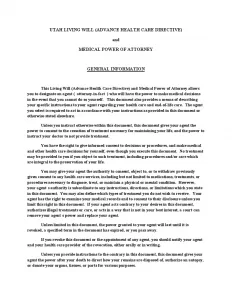Free Utah Living Will Form
A living will in Utah, also known as an advance health care directive, is a legal document that allows you to outline your preferences for medical treatment in situations where you may be unable to communicate your decisions due to illness or incapacity. This document covers decisions about life-sustaining treatments, resuscitation, and other critical care options.
The Utah living will form is a part of a broader advance health care directive that includes naming an agent authorized to make health care decisions on your behalf. The living will form a portion of the directive specifying your wishes regarding medical interventions, ensuring that your healthcare providers and loved ones understand and respect your preferences. This helps to prevent needless or undesired therapy and offers clarity and advice during stressful situations.
Signing Requirements and Laws
Creating a living will in Utah involves adhering to specific legal requirements to ensure the document is valid and enforceable. The Utah Code, Title 75, Chapter 2a, outlines the rules and regulations for executing an Advance Health Care Directive, which includes the living will:
- Section 75-2a-107 explains how an Advance Health Care Directive becomes operative.
- Section 75-2a-114 discusses the revocation process for an Advance Health Care Directive.
- Section 75-2a-117 provides the statutory form for the living will.
Regularly reviewing your living will is essential to ensure it reflects your current wishes. Any updates or changes must follow the same signing and witnessing procedures to be legally binding.
To properly execute a living will in Utah, the following steps must be followed:
- The individual creating the living will (the declarant) must be at least 18 years old and of sound mind.
- The living will must be in writing.
- The declarant must sign the document. If the declarant is unable to sign, another individual can sign on their behalf in their presence and at their direction.
- The living will must be signed by one disinterested witness, who must also sign the document.
Witnesses cannot be related to the declarant by blood, marriage, or adoption. They also cannot be entitled to any part of the declarant’s estate by will or by law, nor can they be directly responsible for the declarant’s medical care. Although notarization is not required, preventing any challenges to the document’s validity is highly recommended.
Utah Living Will Form Details
| Document Name | Utah Living Will Form |
| State Form Name | Utah Advance Health Care Directive |
| Signing Requirements | One Witness |
| Validity Requirements | Section 75-2a-104 |
| Powers Limitation | Section 75-2a-107 |
| State Laws: Utah Code, Title 75, Chapter 2a | |

Popular Local Living Will Forms
Steps to Fill Out the Form
Filling out the advance health care directive in Utah ensures that your healthcare preferences are known and respected if you cannot communicate them yourself. Follow these steps to complete the form accurately:
1. Fill in Personal Information
Begin by filling out your personal information on the first page of the form. This field includes your full name, street address, city, state, zip code, telephone numbers (home and cell), and birth date. Ensure all information is accurate to establish your identity.
2. Appoint an Agent
In Part I of the document, decide if you want to appoint a health care agent. If you choose to appoint an agent, fill in their full name, address, and contact information, and do the same for an alternate agent if you wish. If you do not want to appoint an agent, simply initial the box indicating that choice and move on to Part II.
3. Define the Agent’s Authority
Detail the specific powers you grant to your health care agent. This part includes decisions about accepting or refusing medical treatment, hiring health care providers, accessing medical records, and making other necessary health care decisions. Be sure to specify any limits to these powers if desired.
4. Additional Powers and Guardianship
If you want to give your agent additional powers, such as accessing your medical records at any time or admitting you to a healthcare facility, initial the appropriate “YES” options. Also, decide if you would like your agent or alternate agent to serve as your guardian should you become incapacitated, and initial the “YES” option if so.
5. Document Your Health Care Wishes
In Part II, outline your health care wishes in the event of terminal illness or incapacity. Choose from the options provided to specify whether you want treatments that prolong life, prefer comfort care only, or want your agent to decide. Initial next to your choice and provide any additional comments if necessary.
6. Sign and Date the Directive
Once you have completed the form, sign and date it at the end of Part IV to make it legally binding. This act confirms that you understand your choices and are mentally competent to make these decisions.
7. Witness Signature
Have the directive signed by a witness who meets the criteria specified in the document (not related to you, not a beneficiary, etc.). The witness must also provide their contact information and sign the form, attesting that they witnessed you signing the directive voluntarily.

Below are various other Utah templates completed by our users. Try our simple builder to customize these forms to your preferences.
